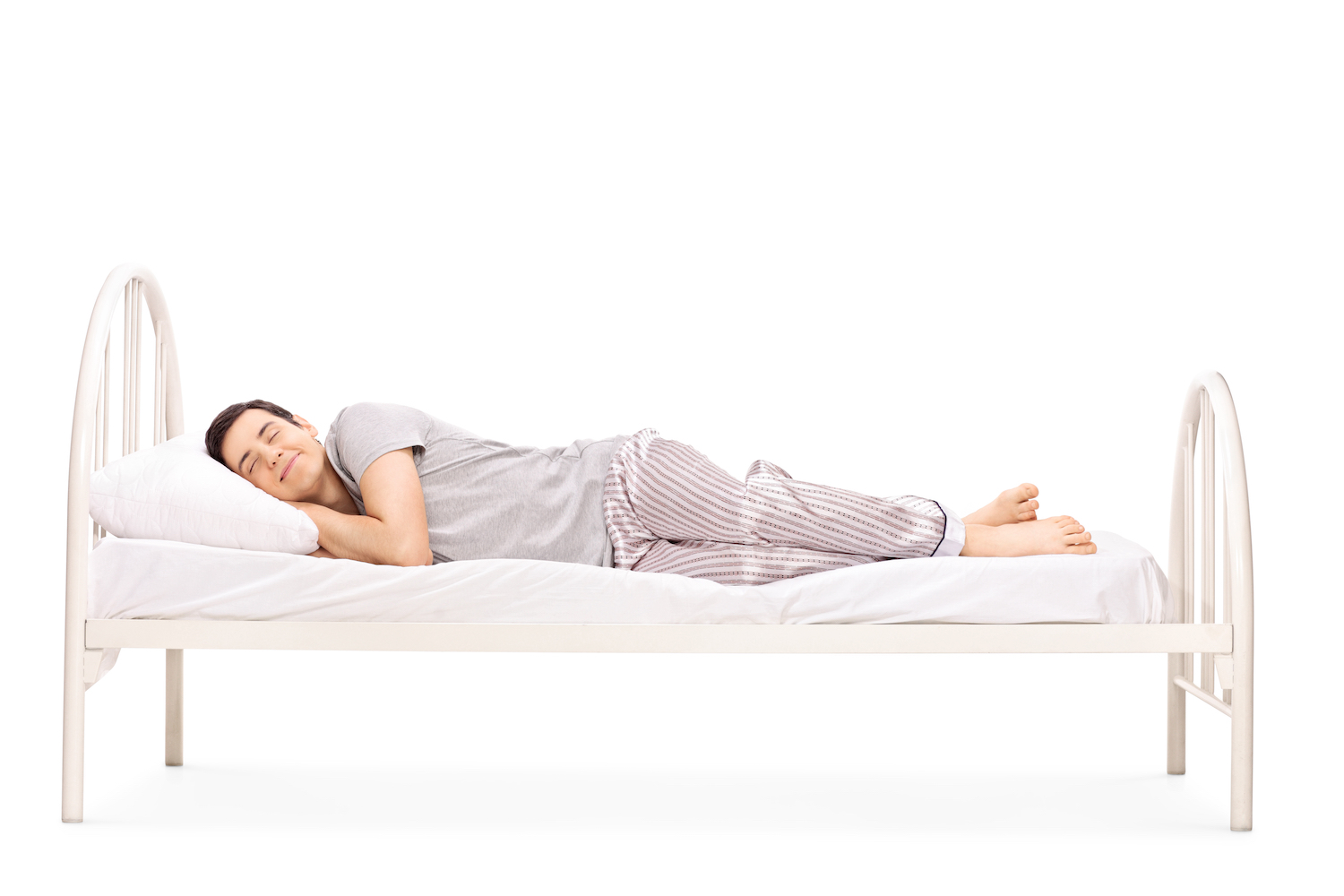At a Glance
- Adults on twin mattresses sleep 22 minutes more than average, the highest among mattress sizes, according to a survey.
- 52% of adults sleep on a queen-size bed.
- 34.7% of adults sleep on foam mattresses, and 30.3% sleep on innerspring.
- Adults sleep the longest on innerspring mattresses, but those on latex mattresses report the highest sleep quality.
- Adults who primarily sleep on water beds report the least amount of sleep and lowest sleep quality.
More than half of U.S. adults (52%) sleep on a queen mattress, according to two surveys by The Sleep Doctor. And 65% sleep on a foam or innerspring mattress, with foam (34.7%) slightly more popular than innerspring (30.3%).
But just because those mattress sizes and types are the most popular doesn’t mean they lead to the most or best sleep.
In fact, adults who sleep on twin-size mattresses sleep 18 more minutes a night than those on queens and 22 more minutes a night than average — the most of any mattress size. Adults on innerspring mattresses average seven more minutes of sleep a night than average, the highest of any mattress type.
Of course, quality counts as much as quantity. Adults who sleep on latex mattresses report the highest percentage of “above average” sleep, and they’re 33.7% more likely to do so than adults on innerspring mattresses.
That doesn’t necessarily mean that all of us should down-size our mattresses or change to a different mattress build. But it does shine a light on how our mattress can best support our sleep health based on our sleep habits, age, and other factors.
Does Bed Size Affect Sleep?
There are many reasons to sleep on a larger bed. Many people do: King and California king mattresses are second only to queen mattresses in popularity, with 25.1% of respondents reporting they sleep on one. Survey respondents on king mattresses sleep an average of seven minutes more a night than those who choose queen mattresses, and 11 minutes more than the average.
Some people just need the space. At 6 feet, 4 inches tall, Corey King, 28, of Nashville, Tennessee, says he needs the space on a California king — longer than a standard king bed — for his legs to fit.
Lisa Frost, 57, of Potomac, Maryland, says that she and her husband have slept on a king for three decades. And she notices the difference when she’s not.
“I never sleep as well on vacation as I do at home,” she says. “If we end up in a queen bed, I can’t quite find the right spacing for myself. I kick my husband all night, not because he snores.”
There could be many reasons, however, why the 11% of survey respondents who sleep on twin or twin XL mattresses sleep longer than everyone else, including 29 minutes longer than the 11.9% of respondents who sleep on full or double mattresses.
“People sleeping on twin mattresses likely live alone, meaning that they can optimize their sleep environment and routine,” says David Rubin, certified sleep science coach and director of product testing at The Sleep Doctor. “They [may] have no kids or partners to work around.”

Age could also be a factor. Gen Z sleepers, or those ages 25 and younger, were 84.9% more likely than average to sleep on a twin or twin XL bed. Some could be like Ariana Ciancio, 20, of Tewksbury, Massachusetts, who went from sleeping on a full-size bed at home to a twin at college.
It was “definitely an adjustment,” she says. “I sleep way better on the full [bed] back at home.”
Deciding Which Type of Mattress is Good For Sleep
There was also a correlation between age and mattress type. Survey respondents ages 55 and older were 51.3% more likely than Gen Z sleepers to choose an innerspring mattress. Innerspring sleepers averaged four minutes more sleep each night than those on foam.
That could have to do with innersprings’ construction and support.
“An innerspring mattress almost always provides support compared to an all-memory-foam mattress, which can be less predictable,” Rubin says. “That feeling of sinking into memory foam might be a major adjustment if you’re used to more support. Plus, memory foam would sleep hotter, so it could be uncomfortable for some sleepers.”
Rubin adds that foam mattresses have become more ubiquitous in recent years at a lower price point, which may explain why they edged out innersprings as the most popular mattress construction in the survey. At 19.9%, adults on innerspring mattresses were also more likely to report “poor” sleep than on foam (15.2%), hybrid (14.8%), or latex (5.7%), which had the highest quality rating.
“Foam cradles your body usually better than a true innerspring,” says Dr. Michael J. Breus of the sleep doctor, who adds that foam can be a good choice for people with low back pain. That could help explain why 55.5% of foam mattress users report “above average” sleep, which is slightly more than hybrid mattresses (53.7%) or innerspring (51.3%) .
Innersprings’ comfort layers “will vary more,” Rubin says, and mattress age can be a factor. Improper support from a sagging mattress can have adverse effects on our bodies, and thus our sleep, particularly as we age.
As for the least effective mattress type, according to the surveys: That distinction belonged to water beds, on which adults sleep 33 minutes less than average every night. The 26.9% of water bed sleepers rating their sleep as poor also was the highest of any mattress type.
Considering Sleep Positions
Sleeping positions influence mattress preference. Ciancio, for instance, prefers a larger bed because of the way she sleeps.
“I like to sleep in the fetal position, for the most part,” she says. “And I like to barricade myself in my bed with two pillows on either side of my body. That’s a little difficult when your bed is so tiny. The pillows fall off, and that drives me crazy.”
According to the surveys, 59.6% of adults fall asleep on their sides, 20.9% fall asleep on their backs, and 17.5% fall asleep on their stomachs. That changes slightly when we wake up, with 51.8% of respondents waking up on their side, 30.4% waking up on their back, and 15.5% waking up on their stomach.
Side sleepers, more so than back or stomach sleepers, tend to sleep on various mattress types.
A foam mattress can be great for people who tend to sleep on their sides because “it relieves pressure on the shoulders, hips, and ankles,” Rubin says. And the share of foam sleepers who sleep on their side is right at the survey average.
For stomach sleepers, latex or hybrid mattresses are better.
“They offer more support than most memory foam mattresses,” Rubin says. “The construction will also help to dissipate heat away from the body.” In the surveys, 18.3% of those who sleep on hybrid mattresses fall asleep on their stomachs, the most of any mattress type.
Although only 2.8% of survey respondents sleep on a latex mattress, they reported the highest quality sleep.
“Latex is a great mattress material, though it’s almost always more expensive and takes some getting used to, which probably contributes to lower usage,” Rubin says. “Latex provides ample contouring but doesn’t heat up and get softer like memory foam does. It sleeps cooler and is easy to move around on.”
Dr. Breus is also a fan: “I love latex mattresses,” he says.
“People are very good at determining how they feel about the quality of their sleep. Latex is a product that does basically what all the other materials do, but combined,” he says.
Methodology
The surveys commissioned by The Sleep Doctor were conducted on the online survey platform Pollfish on Nov. 29, 2022, and Feb. 27, 2023. Each set of results is from 1,250 survey participants in the United States who were ages 18 or older at the time of the surveys and who say they sleep on a mattress in their primary residence. All respondents attested to answering the survey questions truthfully and accurately.
References (1)
Caggiari, G., Talesa, G. R., Toro, G., Jannelli, E., Monteleone, G., & Puddu, L. (2021). What type of mattress should be chosen to avoid back pain and improve sleep quality? Review of the literature. Journal of orthopaedics and traumatology : official journal of the Italian Society of Orthopaedics and Traumatology, 22(1), 51. https://pubmed.ncbi.nlm.nih.gov/34878594/
Ask the Sleep Doctor
Have questions about sleep? Submit them here! We use your questions to help us decide topics for future articles, videos, and newsletters. We try to answer as many questions as possible. You can also send us an email. Please note, we cannot provide specific medical advice, and always recommend you contact your doctor for any medical matters.







